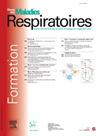Involvement of epithelial CD146 in severe asthma
IF 0.5
4区 医学
Q4 RESPIRATORY SYSTEM
引用次数: 0
Abstract
Introduction
Asthma is a chronic lung disease affecting 300 million people worldwide, 2-10 % of whom suffer from severe asthma. In asthma, the bronchial epithelium is dysregulated, contributing to the pathophysiology of the disease. CD146 is an adhesion molecule that is highly expressed on all the cells from the vascular system, including endothelial cells. It is also expressed by epithelial cells, but its functions in these cells are poorly understood, as is its role in severe asthma. The aim of our study is to elucidate the role of CD146 in the bronchial epithelium and its implication in severe asthma.
Methods
Bronchial epithelia of healthy controls and severe asthma patients were reconstituted in vitro using air-liquid interface culture. Measurements of CD146 expression were made on differentiated epithelium (n = 20 control and 20 severe asthma patients). Then, undifferentiated and differentiated bronchial epithelial cells were sorted based on the expression level of CD146. The sorted undifferentiated bronchial epithelial cells were cultured and monitored during the differentiation process until obtention of a fully differentiated epithelium (n = 3). The sorted differentiated bronchial epithelial cells were used to perform RNA-Seq experiments (n = 4).
Results
We showed that CD146 is highly expressed in severe asthma patients compared to healthy controls both at mRNA and protein levels in differentiated epithelium. Then, we have shown that CD146 expression is not ubiquitous in the differentiated bronchial epithelium. Cell sorting and RNA-seq experiments demonstrated that CD146 is mostly expressed by the basal epithelial cells in the differentiated epithelium. Finally, morphological analysis revealed that CD146 seems to play a role in the bronchial epithelium differentiation process. Indeed, fully differentiated epithelium obtained from CD146+ and CD146− sorted undifferentiated bronchial epithelial cells were different in morphology and cell composition.
Conclusion
Our results suggest that CD146 is only expressed by basal cells of the bronchial epithelium and supports an important role in the differentiation of this epithelium. Moreover, we demonstrated that CD146is overexpressed in severe asthma, suggesting a possible role of this molecule in this disease notably during repair epithelial process.
上皮CD146在严重哮喘中的参与
哮喘是一种慢性肺部疾病,影响全世界3亿人,其中2- 10%患有严重哮喘。在哮喘中,支气管上皮是失调的,有助于疾病的病理生理。CD146是一种粘附分子,在包括内皮细胞在内的所有血管系统细胞上高度表达。它也在上皮细胞中表达,但其在这些细胞中的功能以及在严重哮喘中的作用尚不清楚。我们的研究目的是阐明CD146在支气管上皮中的作用及其在严重哮喘中的意义。方法采用气液界面培养法体外重建健康对照和重症哮喘患者的支气管上皮。在分化上皮(对照组20例,重症哮喘患者20例)上检测CD146的表达。然后,根据CD146的表达水平对未分化和分化支气管上皮细胞进行分类。将经分选的未分化支气管上皮细胞培养并监测其分化过程,直至发现完全分化的支气管上皮细胞(n = 3)。将分选的已分化支气管上皮细胞进行RNA-Seq实验(n = 4)。结果我们发现CD146在重症哮喘患者的分化上皮中mRNA和蛋白水平均高于健康对照组。然后,我们发现CD146在分化的支气管上皮中并不普遍表达。细胞分选和RNA-seq实验表明CD146主要由分化上皮中的基底上皮细胞表达。最后,形态学分析显示CD146似乎在支气管上皮分化过程中发挥作用。事实上,从CD146+和CD146 -分选的未分化支气管上皮细胞中获得的完全分化上皮在形态和细胞组成上是不同的。结论CD146仅在支气管上皮基底细胞中表达,并在支气管上皮的分化中发挥重要作用。此外,我们证实cd146在严重哮喘中过表达,这表明该分子可能在这种疾病中发挥作用,特别是在修复上皮过程中。
本文章由计算机程序翻译,如有差异,请以英文原文为准。
求助全文
约1分钟内获得全文
求助全文
来源期刊

Revue des maladies respiratoires
医学-呼吸系统
CiteScore
1.10
自引率
16.70%
发文量
168
审稿时长
4-8 weeks
期刊介绍:
La Revue des Maladies Respiratoires est l''organe officiel d''expression scientifique de la Société de Pneumologie de Langue Française (SPLF). Il s''agit d''un média professionnel francophone, à vocation internationale et accessible ici.
La Revue des Maladies Respiratoires est un outil de formation professionnelle post-universitaire pour l''ensemble de la communauté pneumologique francophone. Elle publie sur son site différentes variétés d''articles scientifiques concernant la Pneumologie :
- Editoriaux,
- Articles originaux,
- Revues générales,
- Articles de synthèses,
- Recommandations d''experts et textes de consensus,
- Séries thématiques,
- Cas cliniques,
- Articles « images et diagnostics »,
- Fiches techniques,
- Lettres à la rédaction.
 求助内容:
求助内容: 应助结果提醒方式:
应助结果提醒方式:


